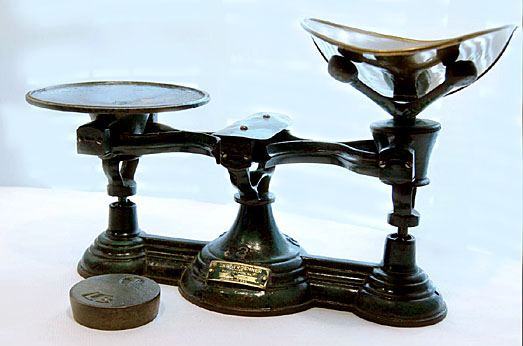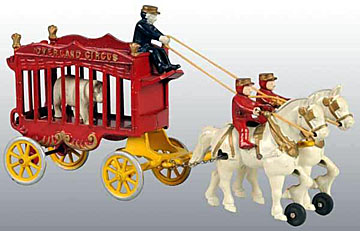 QUESTION: Ever since I was a little boy, I’ve had a fascination with scales. I love weighing things. Now that I’m older, that fascination has turned to a passion for collecting old scales. Currently, I have about 10 scales of varying ages that I acquired from various sources over the years. I’d really like to expand my collection, but I don’t know much about the history of scales and don’t really know where to start. Can you help me?
QUESTION: Ever since I was a little boy, I’ve had a fascination with scales. I love weighing things. Now that I’m older, that fascination has turned to a passion for collecting old scales. Currently, I have about 10 scales of varying ages that I acquired from various sources over the years. I’d really like to expand my collection, but I don’t know much about the history of scales and don’t really know where to start. Can you help me?
ANSWER: You have a very unique interest. Scales and other weighing devices are forms of scientific instruments. Scales have played an important role in economies around the world throughout history.
 The earliest known weighing scales date back to ancient Egypt and Rome. Some of the earliest examples of weight measurement consisted of a simple rod suspended by a string in the middle. The user attached a pan to each end. In one pan, he placed the item, such as a sack of gold coins, to be weighed and in the other stones representing a known weight until he balanced the rod. By calculating the total of the known weights, the user could determine the weight of the object in the other pan.
The earliest known weighing scales date back to ancient Egypt and Rome. Some of the earliest examples of weight measurement consisted of a simple rod suspended by a string in the middle. The user attached a pan to each end. In one pan, he placed the item, such as a sack of gold coins, to be weighed and in the other stones representing a known weight until he balanced the rod. By calculating the total of the known weights, the user could determine the weight of the object in the other pan.
The ancient Egyptians used balance scales for trade and commerce Scales were also important religious symbols. The primary role of the Egyptian goddess of justice, called Maat, was to assist Osiris in the weighing of the heart in the judgement of the dead. The Ancient Egyptian Book of the Dead depicts a scene in which a scribe's heart is weighed against the feather of truth.
 The original form of a balance consisted of a beam with a fulcrum at its center. For highest accuracy, the fulcrum would consist of a sharp V-shaped pivot seated in a shallower V-shaped bearing. Balance scales that required equal weights on each side of the fulcrum have been used by everyone from apothecaries and assayers to jewelers and postal workers.
The original form of a balance consisted of a beam with a fulcrum at its center. For highest accuracy, the fulcrum would consist of a sharp V-shaped pivot seated in a shallower V-shaped bearing. Balance scales that required equal weights on each side of the fulcrum have been used by everyone from apothecaries and assayers to jewelers and postal workers.
The Romans also used balance scales for trade and taxation purposes, as well as in the production of coins.
During medieval and Renaissance times, more precise weighing scales appeared. Beam scales, for example, used a lever system to increase precision and accuracy. In the 16th century, the invention of the steelyard, a type of lever scale, allowed for even greater accuracy in weighing objects. Ddesigned to be mounted to a wall, the most ingenious ones could be folded against the wall and moved out of the way when not in use.
 Coin-operated weighing machines also became popular during this time, allowing merchants to charge customers based on the weight of the goods they were purchasing. Weighing scales became essential for commerce during this period, with merchants using them to ensure fair trade and prevent fraud.
Coin-operated weighing machines also became popular during this time, allowing merchants to charge customers based on the weight of the goods they were purchasing. Weighing scales became essential for commerce during this period, with merchants using them to ensure fair trade and prevent fraud.
In 1669 the Frenchman Gilles Personne de Roberval presented a new kind of balance scale to the French Academy of Sciences. His scale consisted of a pair of vertical columns separated by a pair of equal-length arms and pivoting in the center of each arm from a central vertical column, creating a parallelogram. A peg extended from the side of each vertical column. To the amazement of observers, no matter where Roberval hung two equal weight along the peg, the scale still balanced. In this sense, the scale was revolutionary: it evolved into the more-commonly encountered form consisting of two pans placed on vertical column located above the fulcrum and the parallelogram below them. The advantage of the Roberval design was that no matter where equal weights had been placed in the pans, the scale would still balance.
In the 18th century, spring scales appeared. To produce these scales, a manufacturer would use the resistance of a spring to calculate weights, which could be read automatically on the scale’s face. The ease of use of spring scales over balance scales was what led most post offices to outfit their clerks with spring postal scales.
 The Industrial Revolution brought about the development of mechanical weighing scales. Spring scales, invented in the 18th century, used a spring to measure weight. Industries such as agriculture and manufacturing commonly used them. Platform scales, invented in the 19th century, used a lever and counterbalance system, enabling manufacturers and merchants to weigh heavy loads such as industrial machinery.
The Industrial Revolution brought about the development of mechanical weighing scales. Spring scales, invented in the 18th century, used a spring to measure weight. Industries such as agriculture and manufacturing commonly used them. Platform scales, invented in the 19th century, used a lever and counterbalance system, enabling manufacturers and merchants to weigh heavy loads such as industrial machinery.
The traditional scale consists of two plates or bowls suspended at equal distances from a fulcrum. One plate holds an object of unknown mass, while objects of known mass, called weights, could be added to the other plate until the plates leveled off, indicating the masses are equal. The perfect scale rests at neutral.
A spring scale, on the other hand, made use of a spring of known stiffness to determine mass. Suspending a certain mass will extend the spring by a certain amount depending on the spring's stiffness. The heavier the object, the more the spring stretches.
 One of the most common types of spring scales was the kitchen scale—also known as a family or dial scale. Designed for horizontal surfaces, these vintage kitchen scales used the weight of goods in a pan at the top of the scale to force the spring down. Such scales, sold by Sears Roebuck and Montgomery Ward, became common in early-20th-century households. Many had flat weighing surfaces but some had shallow pans on top. Companies such as Salters, Chatillon, and Fairbanks made both.
One of the most common types of spring scales was the kitchen scale—also known as a family or dial scale. Designed for horizontal surfaces, these vintage kitchen scales used the weight of goods in a pan at the top of the scale to force the spring down. Such scales, sold by Sears Roebuck and Montgomery Ward, became common in early-20th-century households. Many had flat weighing surfaces but some had shallow pans on top. Companies such as Salters, Chatillon, and Fairbanks made both.
 One specialized type of spring scale was the egg scale, which grocers used to compute the weight of one egg or a dozen eggs. It also made it possible to classify eggs as to size—small, medium, large, or extra large. Jiffy-Way scales, made in Owatonna, Minnesota, beginning in 1940, became popular with collectors for their attractive red painted-metal housings. Another Minnesota company, Specialty Manufacturing Company made the Acme egg scale.
One specialized type of spring scale was the egg scale, which grocers used to compute the weight of one egg or a dozen eggs. It also made it possible to classify eggs as to size—small, medium, large, or extra large. Jiffy-Way scales, made in Owatonna, Minnesota, beginning in 1940, became popular with collectors for their attractive red painted-metal housings. Another Minnesota company, Specialty Manufacturing Company made the Acme egg scale.
The weights used to balance scales varied from round, coin-like objects, each weighing a different incremental amount, to fancier ones shaped like bells. During the 19th and early 20th century, most scales were made of brass and/or cast metal.
 One of the most common antique scales is the postal scale. While those used in post offices were more elaborate, the basic design of inexpensive postal scales, sold in office supply stores, hasn’t changed since the late 19th century.
One of the most common antique scales is the postal scale. While those used in post offices were more elaborate, the basic design of inexpensive postal scales, sold in office supply stores, hasn’t changed since the late 19th century.
In the 19th century, some merchants used portable suspension balance scales to weigh coins. Often the value of the gold in a coin exceeded the coin’s stamped denomination. These antique scales, designed to fit into wooden or metal cases, could be hung from the nearest hook. They included brass pans and cast iron or lead weights.
Another type of balance scale had a weighing pan on one side and an arm on the other. Known as an unequal arm balance scale, this variety had the counterweight built into the device.
 Counter scales used in dry-goods stores featured Japanned cast iron and bronze trim. Made by companies such as Howe and Fairbanks, the footed tin pans of these scales were often oblong, some encircled at one end so bulk items could be easily poured into a bag. Seamless pans were typically stamped from brass and given style names like Snuff, the smallest, and Birmingham, the largest. Manufacturers designed some counter scales for measuring spices while others weighed slices of cake.
Counter scales used in dry-goods stores featured Japanned cast iron and bronze trim. Made by companies such as Howe and Fairbanks, the footed tin pans of these scales were often oblong, some encircled at one end so bulk items could be easily poured into a bag. Seamless pans were typically stamped from brass and given style names like Snuff, the smallest, and Birmingham, the largest. Manufacturers designed some counter scales for measuring spices while others weighed slices of cake.
Scales come in all sizes and varieties and prices, making them an excellent item with which to begin or expand a collection.
To read more articles on antiques, please visit the Antiques Articles section of my Web site. And to stay up to the minute on antiques and collectibles, please join the over 30,000 readers by following my free online magazine, #TheAntiquesAlmanac. Learn more about "The Vernacular Style" in the 2024 Winter Edition, online now. And to read daily posts about unique objects from the past and their histories, like the #Antiques and More Collection on Facebook.






























